Posted: March 16th, 2017 | Author: Special Contributor | Filed under: Events | Tags: IoT, Mobile World Congress, MWC17 | Comments Off on A Storm of IoT Solutions and Use Cases at MWC17
By Malla Poikela and Veli-Pekka Luoma
Here’s an existential question: if you don’t think or talk about the Internet of Things (IoT), do you even exist?
With the increasing number of IoT use cases on display at telco events, that could soon be the reality. It’s no surprise to hear that, according to the findings from the Mobile World Live Annual Industry Survey, IoT is the most attractive new business area for businesses in 2017. IoT, together with 5G, NFV/SDN, artificial intelligence, analytics, and automation, was among the most frequently discussed, debated and showcased topics at this year’s Mobile World Congress.

Discussions at MWC17 focused not on IoT theory, but rather the practical development of IoT applications and solutions, along with tangible real-life use cases. IoT solutions are expected to make life easier, healthier and smarter, and help to conserve the scarcest resource in an individual’s life: time. The solutions keep cities cleaner, safer and more secure. Tens of billions of sensors and connected devices will allow the digital economy to impact every aspect of our lives and improve the quality of life.
A number of these use cases were on showcase at MWC17, ranging from health services to IoT-enabled camera drones, location services to smart lighting, fitness to augmented reality/virtual reality (AR/VR), smart factories to connected dogs, and autonomous cars to self-service retail stores, to mention a few. Never before MWC had exhibited so much IoT, with leading Tier-1 operators demoing a range of practical solutions including a theft prevention solution for cars, mopeds and bikes, smart rubbish collection, livestock tracking, remote city lighting control, and remote health monitoring.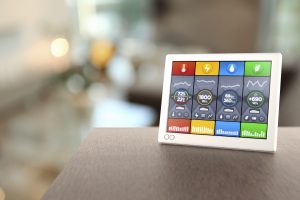
The conversation also revolved around the IoT network, including looks at LoRa, Sigfox, NB-IoT, LTE-M and 5G. 5G was heavily discussed throughout MWC17, in particularly in relation to certain IoT use cases like driverless cars, robo-taxis and remote surgical operations that mandate ultra-low ’millisecond’ latency, vast amounts of data, and frictionless, stable and high bandwidth data speeds. For example, Renault-Nissan has set a goal to roll out 10 car models with autonomous driver functionality by 2020. At the same time, LoRa Alliances and Sigfox are both rapidly expanding globally: LoRa, with its 400+ strong member alliance, has 34 publicly announced operators and Sigfox is already available in over 30 countries.
Discussions around advanced sensor technology noted the remarkable size and duration of the batteries that power these devices. IoT-enabled sensors are extremely small, but their batteries can last for up to 10 years, enabling the long-term monitoring of movement, location, temperature, skin moisture, activity, blood pressure, heart beat and many more factors. We also learned about a new material called Graphene – invented in 2004 and later the subject of a Nobel prize in physics – that enables the development of entirely new active sensors that could even be installed inside the human body.
 Far away are times when MWC was just a showcase for telecom technology. Other industries presence has become a norm, the IoT is enabling the creation of intelligent and connected systems that will mean the entry of more new players, startups and industries at MWC. Car manufacturers, financial service providers, media companies, medical companies, smart city operators, transportation companies, retailers, industrial companies, agricultural entities and many more are involved or starting to get involved as they try to get their hands on with the latest transformative IoT solution.
Far away are times when MWC was just a showcase for telecom technology. Other industries presence has become a norm, the IoT is enabling the creation of intelligent and connected systems that will mean the entry of more new players, startups and industries at MWC. Car manufacturers, financial service providers, media companies, medical companies, smart city operators, transportation companies, retailers, industrial companies, agricultural entities and many more are involved or starting to get involved as they try to get their hands on with the latest transformative IoT solution.
At the same time, operators certainly need to talking to those businesses to seek new avenues of revenue growth. By enabling digital services for IoT, telcos can dramatically expand their number of potential customers enjoying digital services. In time, operators will see, meet and cooperate with many more of these use-case driven players in events like MWC.
Posted: May 17th, 2016 | Author: Malla Poikela | Filed under: Events | Tags: Intelligent Fast Data, IoT, IoTNordic | Comments Off on #IoTNordic 2016 Recap: Spotlight on IoT Partnerships and Potential
Last month, a sold-out crowd of 500 IoT enthusiasts packed into Helsinki’s Kattilahalli conference hall for the Internet of Things 2016 Conference, also known as #IoTNordic. With a DJ playing live music throughout the two-day show, a saxophonist entertaining the crowd in the late afternoon happy hour and outdoor food vans offering tasty meals, the event offered a hip, modern and invigorating atmosphere for lively discussions on the potential and partnerships that define the IoT.
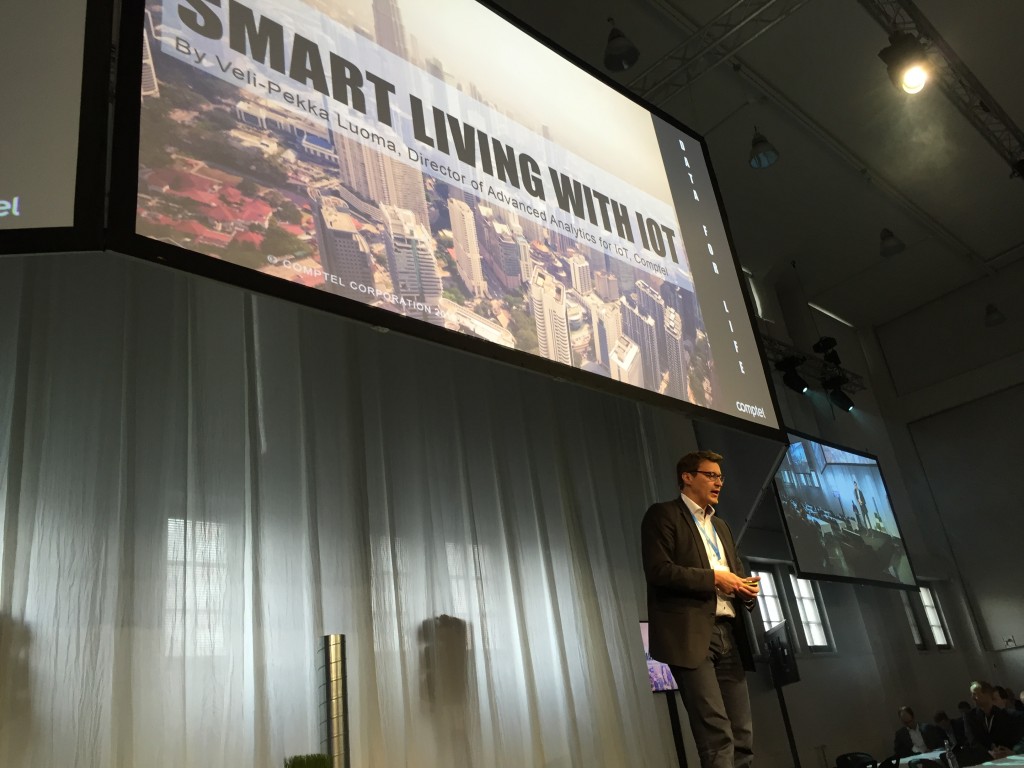
Veli-Pekka Luoma, Comptel
Although environmentalism was a major theme (event organisers used recycled wooden pallets as booth tables, for example), the event and the attendees were focused on different kind of environment: the holistic IoT ecosystem. There was one common denominator: Nearly everyone in attendance, across industries, was looking for technology partners to help them build or expand their own ecosystem of connected device solutions.
Comptel sponsored #IoTNordic and presented a speaking session with our Director of Advanced Analytics for IoT, Veli-Pekka Luoma, about the vital role data plays in the Smart Living movement. Comptel’s Intelligent Fast Data solutions offer businesses the power to sense, understand and act instantly on data “across the board.” Connected devices are another data source that produces aggregated information, alongside customer interactions, the network, social media, location and more. Businesses stand to benefit tremendously by pulling insights from all those different sources and applying insights to real-time actions. Those actions lead to better IoT-enabled experiences.
Industry can remotely monitor heavy machinery to run a “smart factory.” Health care providers can track personal data to offer intelligent preventative care, fleet managers can optimise routes for cargo vehicles, utility providers can provide efficient energy solutions with smart meters, and much more.
It all starts with smarter data. Through experimentation, partnership and solution co-creation, businesses – including operators – can apply data analytics to elevate the IoT beyond simple machine-to-machine communications toward humanistic benefits. #IoTNordic offered several compelling examples of businesses that are already succeeding in the IoT.
Elisa’s IoT Innovation Challenge
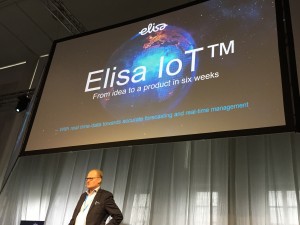
Elisa VP Markku Hollström
The Finnish operator Elisa has enjoyed many successes along its digital transformation. Its IoT service offering is one example. The company offers IoT connectivity, monitoring and analytics to a range of verticals, including a 3D real-time “Smart Factory” dashboard for industry, augmented reality solutions, and analytics-enriched monitoring and email notifications for the marine manufacturer Wärtsilä.
Elisa VP Markku Hollström explained that to succeed in the IoT, you need to experiment and develop a broad network of partners. That enables speed – the company profiled IoT projects that went from ideation to product in just six weeks. It’s also why the company is inviting businesses to participate in the Elisa Innovation Challenge, which will reward up to €85,000 in prizes to entrants who create innovative corporate and Smart Home IoT solutions.
Technology, Customer Experience the Focus for Tesla
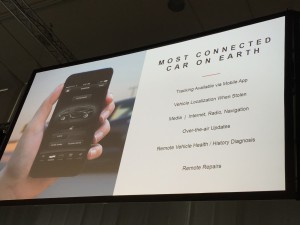
Tesla presentation at IoT Nordic
The electric car manufacturer Tesla says it is not in the business of selling luxury vehicles. At the show, the company’s speaker said the company’s focus is actually in transitioning the world toward safer, sustainable transportation. The IoT plays a big role in that: Tesla says its vehicles are the most connected cars on Earth, and their mission is to incorporate technology to create a software-based, analytics-informed driving experience. Even their car buying experience is innovative; it’s entirely online, making it a modern, customer-focused approach to purchasing.
Are Device Implants the Future of Health?
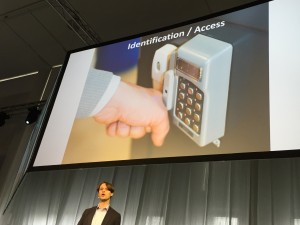
Hannes Sjöblad, BioNyfiken
Hannes Sjöblad of BioNyfiken presented a fascinating look at the role of NFC implants in human health, which his company says is humanity’s “personal key to the IoT”. This technology already exists – in fact, we saw a live demo at the end of his presentation of a human implant placed into a person’s hand. While also a bit scary, the demo did show the amazing potential of implanted devices to enable everyday individuals to “speak” to connected devices.
There are simple but very relevant use cases, like replacing keys, ID cards, tickets and boarding passes with implanted chips, and use cases that are more humanistic. Personalised chips could ensure a gun can’t be operated by an unauthorised user, for example, or even play a role in curing blindness, deafness and paralysis.
Securing the IoT
Of course, any conversation about the many uses cases for the IoT eventually falls back on security concerns. In his keynote speech, Mikko Hyppönen, Chief Research Officer of F-Secure explained that the IoT will only expand the number of threat vectors (how do you secure your Wi-Fi if it’s being shared by your refrigerator?), creating more opportunity for highly sophisticated cyber criminals and making it more difficult for consumers to maintain privacy.
The number and variety of IoT devices will make single-device protection impractical, said Hyppönen. F-Secure, for example, has no interest in developing anti-virus protection for your connected toaster. However, the company does develop full-home Wi-Fi security solutions to ensure every device on the network is secure. Furthermore, F-Secure compensates independent hackers who find holes in their security system, when many of those hackers may have otherwise sold that information to cyber criminals. It’s a good solution for F-Secure: Paying for hackers to find holes in your system is a clever and efficient way to find vulnerable spots in your environment.
As Hyppönen said, ”Web content is not free. It is paid for with your data. It’s paid for with your privacy. And it’s too late to change that. We have raised a whole new generation who are used to having content for ‘free’ on the web. And yet, we don’t understand what this means.”
That’s an important takeaway to keep in mind as businesses and operators tiptoe – or dive head-first – into the futuristic world of the IoT.
Learn more about the IoT opportunity for telco in a new whitepaper from Comptel and Heavy Reading. Download “Smart Cities & Smart Living: The Role of Telecom Operators.”
Posted: January 22nd, 2015 | Author: Special Contributor | Filed under: Industry Insights | Tags: billing, Comptel EventLink, Data Refinery, embedded intelligence, IoT, LTE, mediation, roaming | 3 Comments »
By Katja Kurisjärvi, Marketing Manager, Comptel
In yesterday’s blog post, I highlighted Comptel EventLink 7.0’s key features and mentioned how they comprise the foundation of our Data Refinery solution. Communications service providers (CSPs) and global enterprises alike require a strong technology base to keep up with the standards of nexterday and the high expectations of “Generation Cloud.”
Building on the Comptel EventLink core, with rating and charging components and embedded intelligence, including reporting and monitoring, our Data Refinery solution can enable real-time decision-making and action- triggering. Here are six ways that it can be put to work to drive CSPs’ businesses forward.
1. Beyond traditional billing mediation
“Comptel EventLink can, as always, manage traditional billing mediation tasks, and many of our customers use it for full-blown mediation consolidations,” says Senior Product Manager Tero Lindholm. “The platform is typically used in the OSS/BSS layer, where a Tier 0 or 1 operator with IP, fixed and mobile networks has consolidated all of its services on it.”
However, recently, new and existing Comptel EventLink customers have started to use the software for purposes other than pure billing mediation, taking advantage of its ability to process intelligent data in real time and in any format.
Typically, such cases involve complex event processing (CEP) and refining value out of “Big Data in motion” – data that originates from multiple sources in a real-time environment. The Data Refinery adds intelligence to the data handling, and enables real-time analysis, decisions and actions based on the data going through the system streams. When more hierarchical customer profiling and propensity calculations are needed, the Comptel Social Links analytics add-on is included.
2. Automated campaigns
One of the new purposes for the Data Refinery is real-time analysis with decisions and actions to enable automated campaigning processes. This is something that Comptel has implemented for operators all over the world.
“We are helping operators better understand how their customers are using their services and which offers are most relevant to which individuals,” said Tero.
The Data Refinery combines real-time usage events with a real-time understanding of the subscription and the subscriber profile and location, for example, like whether the subscriber is roaming. The Data Refinery can accumulate different usages, and combine them with real-time analysis, make more relevant offers to the end customers with optimal timing.
Understanding real-time usage is made possible by combining usage events from network elements such as PCRF or OCS (mobile) or CMTS (for IP network), and the subscription information from the CRM. The summary of each customer’s usage, according to his/her subscription and services, is shown immediately in the CSP portal, where end customers can directly monitor their service usage.
Having real-time information about data usage increases customer satisfaction and helps CSPs’ provide more suitable offers based on the real-time understanding of service usage.
3. Economical ways to managing roaming agreements
Comptel is in a good position to help operators solve roaming challenges. The company was a pioneer in rolling out roaming cost control use cases when the EU roaming regulations came into force in 2007. These regulations were intended to regulate the roaming data and voice charges imposed by operators to their subscribers, thus preventing bill shock.
To regulate roaming charges, operators are looking for more economical ways to manage roaming data and agreement processing between different roaming partners. The Comptel EventLink extension, Roaming Management, is used by 20+ operators for managing roaming billing and fraud detection, and for automated processing of partner agreements. The extension supports the TAP/RAP/NRTRDE/RAEX processing in alignment with the GSMA standards and provides full visibility into the configuration of the agreements from test phase through production.
4. Monetising OTT offerings
The Data Refinery can help monetise over-the-top (OTT) offerings. For example, in Asia-Pacific, a Tier 1 customer is using the Data Refinery to collect information related to Google Play purchases. The customer has a revenue-sharing model with the Google Play market place, and the Comptel system provides usage information to revenue-sharing platforms and to the interconnect billing system.
5. Ready for IoT
The Data Refinery is highly suitable for connecting devices and applications, and expanding usability from pure billing mediation tasks to supporting the Internet of Things (IoT) business model.
For instance, since 2013, the Telefonica Group in Europe has used the Data Refinery for processing smart metre usage traffic from Telefonica’s machine-to-machine (M2M) network elements. Smart metres equipped with SIM cards communicate readings over GPRS links, which generate events that the Data Refinery can collect and separate from mobile device usage events, providing the aggregated data to the M2M platform and assurance.
6. LTE leading the data explosion
Increased data usage is clearly visible to the users and developers of Comptel EventLink—a Tier 1 operator’s system, for instance, can now process as much as 500 TB of data daily (comparable to the daily usage of Facebook data).
To cite an example from Tero, the amount of usage events has tripled for an Indonesian customer over the past two years, and is currently hitting 12-13 billion records with each passing day.
“Indonesia is just about to adopt 4G services, and we can expect the number of usage events to multiply as 4G is introduced to tablets, smartphones and other handhelds being used in that region,” noted Tero.
In Italy, a similar explosion was seen earlier this year, where the mobile data packet usage increased by 84 percent in just five months. Not only has LTE created an enormous impact on the volume of network events, it has also increased network complexity. This is because VoLTE based on IMS technology introduces new types of network elements that require high capabilities to collect and correlate different events from different sources, in order to have properly chargeable items for billing and other applications.
It’s no wonder that operators are finding it difficult to handle customers’ appetites for ‘all-you-can-eat’ packages and are consequently moving to capped data plans. Such data plans take advantage of policy control solutions, which restrict available capacity for each customer. Customers who demand the highest bandwidth without limitations must be prepared to pay for it, bringing welcome income for operators still suffering from voice revenue losses.
Want to discuss how else Comptel EventLink 7.0 and our Data Refinery solution can support your business?
Download the presentation below, or email [email protected] for a demo.
Download
This is based on an interview with Senior Product Manager Tero Lindholm.


![]() Far away are times when MWC was just a showcase for telecom technology. Other industries presence has become a norm, the IoT is enabling the creation of intelligent and connected systems that will mean the entry of more new players, startups and industries at MWC. Car manufacturers, financial service providers, media companies, medical companies, smart city operators, transportation companies, retailers, industrial companies, agricultural entities and many more are involved or starting to get involved as they try to get their hands on with the latest transformative IoT solution.
Far away are times when MWC was just a showcase for telecom technology. Other industries presence has become a norm, the IoT is enabling the creation of intelligent and connected systems that will mean the entry of more new players, startups and industries at MWC. Car manufacturers, financial service providers, media companies, medical companies, smart city operators, transportation companies, retailers, industrial companies, agricultural entities and many more are involved or starting to get involved as they try to get their hands on with the latest transformative IoT solution.








